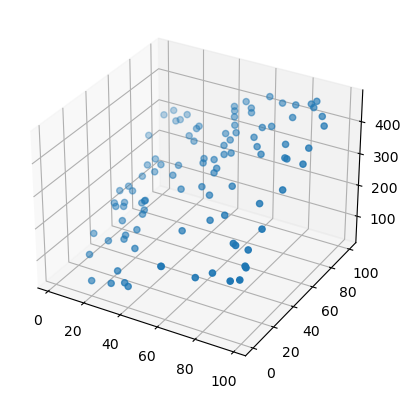Lecture 2 Excercise – 2D regression exercise after the class#
1, you can use the mathematical formulas to estimate the regression coefficients
2, you can also use the sklearn machine learning library for the regression
In the exercise, we provide the solution for the first option, Your task is to use the SKLEARN library to solve the regression and write a short summary
from __future__ import print_function, division
from builtins import range
# Note: you may need to update your version of future
# sudo pip install -U future
import numpy as np
from mpl_toolkits.mplot3d import Axes3D
import matplotlib.pyplot as plt
# load the data
X = []
Y = []
for line in open('data_2d.csv'):
x1, x2, y = line.split(',')
X.append([float(x1), float(x2), 1]) # add the bias term
Y.append(float(y))
# let's turn X and Y into numpy arrays since that will be useful later
X = np.array(X)
Y = np.array(Y)
# let's plot the data to see what it looks like
fig = plt.figure()
ax = fig.add_subplot(111, projection='3d')
ax.scatter(X[:,0], X[:,1], Y)
plt.show()

X.shape, Y.shape
((100, 3), (100,))
# apply the equations we learned to calculate a and b
# numpy has a special method for solving Ax = b
# so we don't use x = inv(A)*b
# note: the * operator does element-by-element multiplication in numpy
# np.dot() does what we expect for matrix multiplication
w = np.linalg.solve(np.dot(X.T, X), np.dot(X.T, Y))
Yhat = np.dot(X, w)
# determine how good the model is by computing the r-squared
d1 = Y - Yhat
d2 = Y - Y.mean()
r2 = 1 - d1.dot(d1) / d2.dot(d2)
print("the r-squared is:", r2)
the r-squared is: 0.9980040612475777

